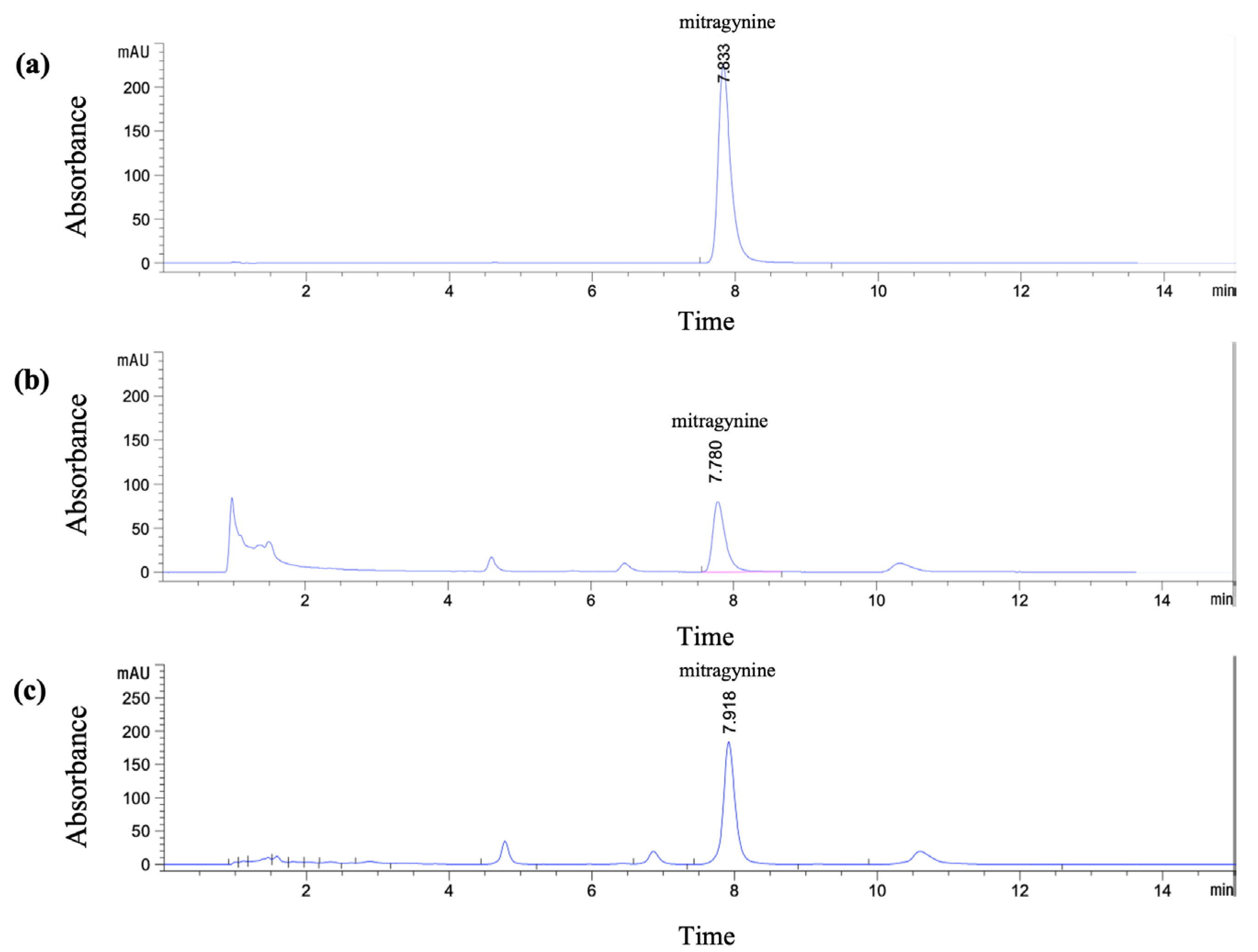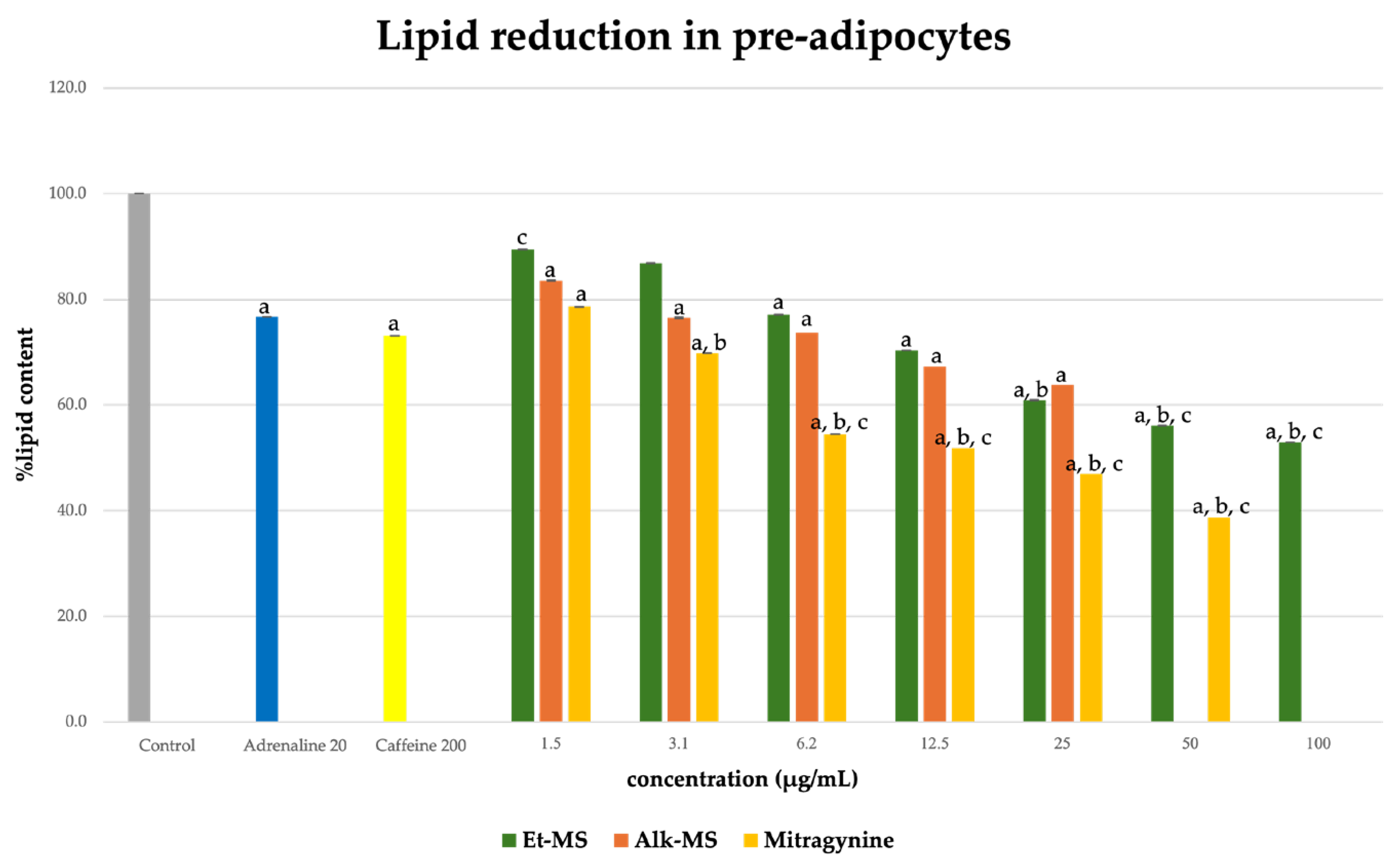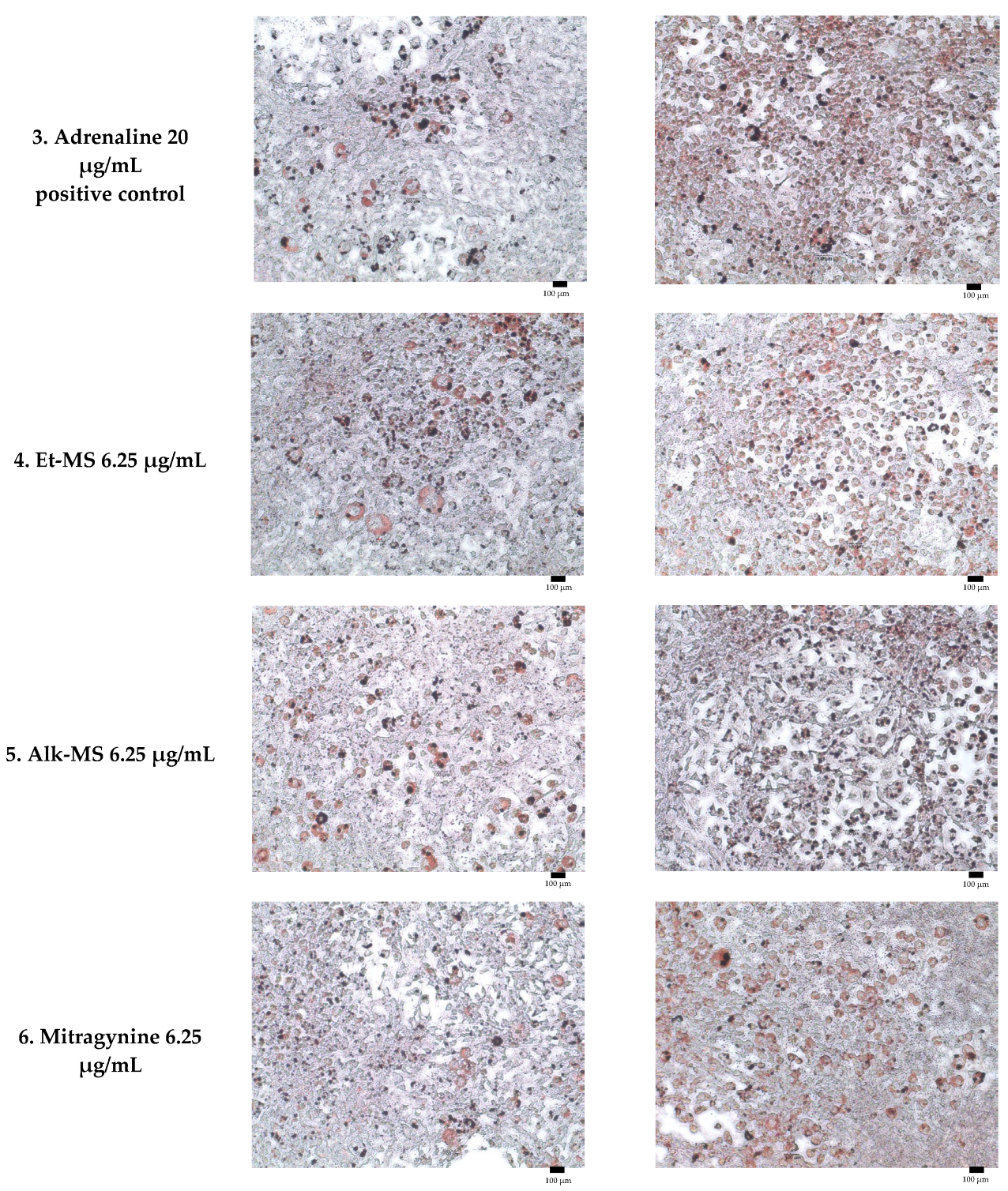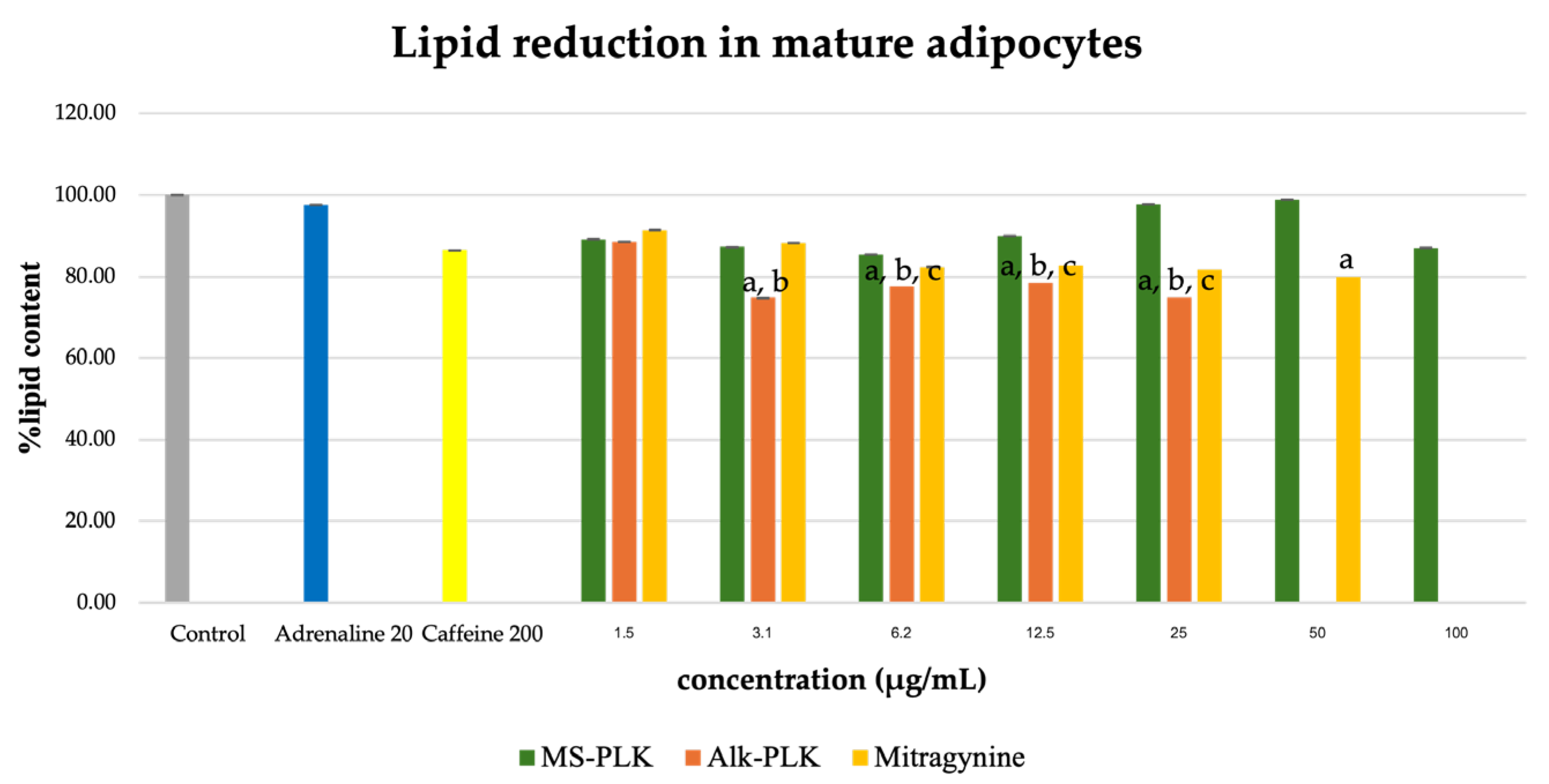Cosmeceutical Potential of Mitragyna speciosa (Kratom): Anti-Adipogenic and Antioxidant Properties of Extracts and Mitragynine
Abstract
1. Introduction
2. Results and Discussion
2.1. HPLC Analysis and Mitragynine Content
2.2. Antioxidant Profiles and Phytochemical Correlations of Kratom Extracts
2.3. Anti-Adipogenic Effects of Kratom Extracts and Mitragynine
Cell Viability
2.4. Inhibitory Effects on Lipid Accumulation During Pre-Adipocyte Differentiation
2.5. Inhibitory Effects on Lipid Accumulation in Mature Adipocytes
3. Discussion
4. Materials and Methods
4.1. Chemicals and Reagents
4.2. Plant Material
4.3. Extraction Process of Kratom Extract and Alkaloidal Extract
4.4. Determination of Mitragynine by HPLC Technique
4.5. Total Phenolic Content
4.6. Determination of Antioxidant Activity
4.6.1. DPPH Radical-Scavenging Assay
4.6.2. ABTS Antioxidant Assay
4.6.3. FRAP (Ferric-Reducing Antioxidant Power) Assay
4.7. Evaluation of Cytotoxicity and Anti-Adipogenic Activity in 3T3-L1 Cells
4.7.1. Cell Line and Culture
4.7.2. Cytotoxicity Assay
4.7.3. Determination of Lipid Accumulation by Oil Red O Staining
- T3-L1 Differentiation and Extract Treatment
- Oil Red O staining
4.8. Statistical Analysis
5. Conclusions
Author Contributions
Funding
Institutional Review Board Statement
Informed Consent Statement
Data Availability Statement
Acknowledgments
Conflicts of Interest
References
- Smitinandan, T. Thai Plant Names, 2nd ed.; Royal Forest Department, Forest Botany Division: Bangkok, Thailand, 2001. [Google Scholar]
- Suwanlert, S. A study of kratom eaters in Thailand. Bull Narc 1975, 27, 21–27. [Google Scholar]
- Takayama, H. Chemistry and pharmacology of analgesic indole alkaloids from the rubiaceous plant, Mitragyna speciosa. Chem. Pharm. Bull. 2004, 52, 916–928. [Google Scholar] [CrossRef]
- Ya, K.; Tangamornsuksan, W.; Scholfield, C.N.; Methaneethorn, J.; Lohitnavy, M. Pharmacokinetics of mitragynine, a major analgesic alkaloid in kratom (Mitragyna speciosa): A systematic review. Asian J. Psychiatry 2019, 43, 73–82. [Google Scholar] [CrossRef]
- Adkins, J.E.; Boyer, E.W.; McCurdy, C.R. Mitragyna speciosa, a psychoactive tree from Southeast Asia with opioid activity. Curr. Top. Med. Chem. 2011, 11, 1165–1175. [Google Scholar] [CrossRef] [PubMed]
- Ponglux, D.; Wongseripipatana, S.; Takayama, H.; Kikuchi, M.; Kurihara, M.; Kitajima, M.; Aimi, N.; Sakai, S. A new indole alkaloid, 7 α-hydroxy-7H-mitragynine, from Mitragyna speciosa in Thailand. Planta Medica 1994, 60, 580–581. [Google Scholar] [CrossRef] [PubMed]
- Takayama, H.; Kurihara, M.; Kitajima, M.; Said, I.M.; Aimi, N. New indole alkaloids from the leaves of Malaysian Mitragyna speciosa. Tetrahedron 1998, 54, 8433–8440. [Google Scholar] [CrossRef]
- Sanderson, M.; Rowe, A. Kratom. CMAJ 2019, 191, E1105. [Google Scholar] [CrossRef]
- Swogger, M.T.; Smith, K.E.; Garcia-Romeu, A.; Grundmann, O.; Veltri, C.A.; Henningfield, J.E.; Busch, L.Y. Understanding kratom use: A guide for healthcare providers. Front. Pharmacol. 2022, 13, 801855. [Google Scholar] [CrossRef]
- Janthongkaw, A.; Klaophimai, S.; Khampaya, T.; Yimthiang, S.; Yang, Y.; Ma, R.; Bumyut, A.; Pouyfung, P. Effect of green and red Thai Kratom (Mitragyna speciosa) on pancreatic digestive enzymes (alpha-glucosidase and lipase) and acetyl-carboxylase 1 activity: A possible therapeutic target for obesity prevention. PLoS ONE 2023, 18, e0291738. [Google Scholar] [CrossRef]
- Cheng, C.; Li, Z.; Zhao, X.; Liao, C.; Quan, J.; Bode, A.M.; Cao, Y.; Luo, X. Natural alkaloid and polyphenol compounds targeting lipid metabolism: Treatment implications in metabolic diseases. Eur. J. Pharmacol. 2020, 870, 172922. [Google Scholar] [CrossRef]
- Ma, Z.; Wang, S.; Miao, W.; Zhang, Z.; Yu, L.; Liu, S.; Luo, Z.; Liang, H.; Yu, J.; Huang, T.; et al. The roles of natural alkaloids and polyphenols in lipid metabolism: Therapeutic implications and potential targets in metabolic diseases. Curr. Med. Chem. 2023, 30, 3649–3667. [Google Scholar] [CrossRef]
- Goh, T.B.; Yian, K.R.; Mordi, M.N.; Mansor, S.M. Antioxidant value and antiproliferative efficacy of mitragynine and a silane reduced analogue. Asian Pac. J. Cancer Prev. 2014, 15, 5659–5665. [Google Scholar] [CrossRef] [PubMed]
- Kruegel, A.C.; Gassaway, M.M.; Kapoor, A.; Váradi, A.; Majumdar, S.; Filizola, M.; Javitch, J.A.; Sames, D. Synthetic and receptor signaling explorations of the mitragyna alkaloids: Mitragynine as an atypical molecular framework for opioid receptor modulators. J. Am. Chem. Soc. 2016, 138, 6754–6764. [Google Scholar] [CrossRef] [PubMed]
- Almoraie, N.M.; Shatwan, I.M. The Potential Effects of Dietary Antioxidants in Obesity: A Comprehensive Review of the Literature. Healthcare 2024, 12, 416. [Google Scholar] [CrossRef] [PubMed]
- Khutami, C.; Sumiwi, S.A.; Ikram, N.K.K.; Muchtaridi, M. The Effects of Antioxidants from Natural Products on Obesity, Dyslipidemia, Diabetes and Their Molecular Signaling Mechanism. Int. J. Mol. Sci. 2022, 23, 2056. [Google Scholar] [CrossRef]
- Fu, M.; Yoon, K.-S.; Ha, J.; Kang, I.; Choe, W. Crosstalk Between Antioxidants and Adipogenesis: Mechanistic Pathways and Their Roles in Metabolic Health. Antioxidants 2025, 14, 203. [Google Scholar] [CrossRef]
- Department of Medical Sciences. Thai Herbal Pharmacopeia 2021 Supplement 2023 (Kratom), 1st ed.; Department of Medical Sciences: Bangkok, Thailand, 2023. [Google Scholar]
- Mudge, E.M.; Brown, P.N. Determination of Mitragynine in Mitragyna speciosa Raw Materials and Finished Products by Liquid Chromatography with UV Detection: Single-Laboratory Validation. J. AOAC Int. 2017, 100, 18–24. [Google Scholar] [CrossRef]
- Heim, K.E.; Tagliaferro, A.R.; Bobilya, D.J. Flavonoid antioxidants: Chemistry, metabolism and structure-activity relationships. J. Nutr. Biochem. 2002, 13, 572–584. [Google Scholar] [CrossRef]
- Rice-Evans, C.; Miller, N.; Paganga, G. Antioxidant properties of phenolic compounds. Trends Plant Sci. 1997, 2, 152–159. [Google Scholar] [CrossRef]
- Chang, W.-T.; Wu, C.-H.; Hsu, C.-L. Diallyl trisulphide inhibits adipogenesis in 3T3-L1 adipocytes through lipogenesis, fatty acid transport, and fatty acid oxidation pathways. J. Funct. Foods 2015, 16, 414–422. [Google Scholar] [CrossRef]
- Prathapan, A.; Krishna, M.S.; Lekshmi, P.; Raghu, K.; Menon, A.N. Modulation of adipogenesis and glucose uptake by Curcuma longa extract in 3T3L1 and L6 cell lines—An in vitro study. Asian Pac. J. Trop. Dis. 2012, 2, S163–S165. [Google Scholar] [CrossRef]
- Ngamdokmai, N.; Ingkaninan, K. Research and development of an anti-cellulite product from Thai herbal compress. Naresuan University: Phitsanulok, Thailand, 2021. [Google Scholar]
- Kraus, N.A.; Ehebauer, F.; Zapp, B.; Rudolphi, B.; Kraus, B.J.; Kraus, D. Quantitative assessment of adipocyte differentiation in cell culture. Adipocyte 2016, 5, 351–358. [Google Scholar] [CrossRef] [PubMed]
- Cai, Y.; Luo, Q.; Sun, M.; Corke, H. Antioxidant activity and phenolic compounds of 112 traditional Chinese medicinal plants associated with anticancer. Life Sci. 2004, 74, 2157–2184. [Google Scholar] [CrossRef] [PubMed]
- Ahmad, B.; Serpell, C.J.; Fong, I.L.; Wong, E.H. Molecular Mechanisms of Adipogenesis: The Anti-adipogenic Role of AMP-Activated Protein Kinase. Front. Mol. Biosci. 2020, 7, 76. [Google Scholar] [CrossRef]
- Lee, H.; Lee, Y.J.; Choi, H.; Ko, E.H.; Kim, J.-W. Reactive Oxygen Species Facilitate Adipocyte Differentiation by Accelerating Mitotic Clonal Expansion. J. Biol. Chem. 2009, 284, 10601–10609. [Google Scholar] [CrossRef]
- Limcharoen, T.; Pouyfung, P.; Ngamdokmai, N.; Prasopthum, A.; Ahmad, A.R.; Wisdawati, W.; Prugsakij, W.; Warinhomhoun, S. Inhibition of α-Glucosidase and Pancreatic Lipase Properties of Mitragyna speciosa (Korth.) Havil. (Kratom) Leaves. Nutrients 2022, 14, 3909. [Google Scholar] [CrossRef]
- Ko, J.; Kim, J.Y.; Kim, J.W.; Yoon, J.S. Anti-oxidative and anti-adipogenic effects of caffeine in an in vitro model of Graves’ orbitopathy. Endocr. J. 2020, 67, 439–447. [Google Scholar] [CrossRef]
- Wang, S.; Liang, X.; Yang, Q.; Fu, X.; Rogers, C.J.; Zhu, M.; Rodgers, B.D.; Jiang, Q.; Dodson, M.V.; Du, M. Resveratrol induces brown-like adipocyte formation in white fat through activation of AMP-activated protein kinase (AMPK) α1. Int. J. Obes. 2015, 39, 967–976. [Google Scholar] [CrossRef]
- Beng, G.T.; Hamdan, M.R.; Siddiqui, M.J.; Mordi, M.N.; Mansor, S.M. A simple and cost effective isolation and purification protocol of mitragynine from Mitragyna speciosa Korth (Ketum) Leaves. Malays. J. Anal. Sci. 2011, 15, 54–60. [Google Scholar]
- Shamima, A.R.; Fakurazi, S.; Hidayat, M.T.; Hairuszah, I.; Moklas, M.A.M.; Arulselvan, P. Antinociceptive action of isolated mitragynine from Mitragyna speciosa through activation of opioid receptor system. Int. J. Mol. Sci. 2012, 13, 11427–11442. [Google Scholar] [CrossRef]
- Khacha-Ananda, S.; Tragoolpua, K.; Chantawannakul, P.; Tragoolpua, Y. Antioxidant and Anti-cancer Cell Proliferation Activity of Propolis Extracts from Two Extraction Methods. Asian Pac. J. Cancer Prev. 2013, 14, 6991–6995. [Google Scholar] [CrossRef]
- Pinchuk, I.; Shoval, H.; Dotan, Y.; Lichtenberg, D. Evaluation of antioxidants: Scope, limitations and relevance of assays. Chem. Phys. Lipids 2012, 165, 638–647. [Google Scholar] [CrossRef]
- Khattak, M.M.A.K.; Taher, M.; Ichwan, S.J.A.; Azahari, N. Selected Herbal Extracts Improve Diabetes Associated Factors in 3T3-L1 Adipocytes. Procedia-Soc. Behav. Sci. 2013, 91, 357–375. [Google Scholar] [CrossRef]
- Wu, M.; Liu, D.; Zeng, R.; Xian, T.; Lu, Y.; Zeng, G.; Sun, Z.; Huang, B.; Huang, Q. Epigallocatechin-3-gallate inhibits adipogenesis through down-regulation of PPARγ and FAS expression mediated by PI3K-AKT signaling in 3T3-L1 cells. Eur. J. Pharmacol. 2017, 795, 134–142. [Google Scholar] [CrossRef]






| Sample/ Positive Control | DPPH EC50 (mg/mL) | ABTS EC50 (mg/mL) | FRAP (g Fe2+/100 g) | Total Phenolic (mg GAE/g) | % w/w Mitragynine |
|---|---|---|---|---|---|
| Et-MS | 0.06 ± 0.00 a | 0.29 ± 0.03 a | 55.54 ± 1.23 a | 149.93 ± 2.16 a | 4.96 ± 0.12 b |
| Alk-MS | 0.17 ± 0.03 b | 0.42 ± 0.02 b | 34.24 ± 0.95 b | 161.45 ± 4.90 b | 28.32 ± 0.37 a |
| Mitragynine | 0.22 ± 0.01 c | 0.16 ± 0.01 c | 36.30 ± 0.44 b | NA | NA |
| Ascorbic acid | 0.002 ± 0.00 d | ND | ND | ND | NA |
| Trolox | ND | 0.04 ± 0.00 d | ND | ND | NA |
Disclaimer/Publisher’s Note: The statements, opinions and data contained in all publications are solely those of the individual author(s) and contributor(s) and not of MDPI and/or the editor(s). MDPI and/or the editor(s) disclaim responsibility for any injury to people or property resulting from any ideas, methods, instructions or products referred to in the content. |
© 2025 by the authors. Licensee MDPI, Basel, Switzerland. This article is an open access article distributed under the terms and conditions of the Creative Commons Attribution (CC BY) license (https://creativecommons.org/licenses/by/4.0/).
Share and Cite
Kaewchompoo, S.; Temkitthawon, P.; Phumlek, K.; Waranuch, N.; Ngamdokmai, N.; Ingkaninan, K. Cosmeceutical Potential of Mitragyna speciosa (Kratom): Anti-Adipogenic and Antioxidant Properties of Extracts and Mitragynine. Molecules 2025, 30, 4256. https://doi.org/10.3390/molecules30214256
Kaewchompoo S, Temkitthawon P, Phumlek K, Waranuch N, Ngamdokmai N, Ingkaninan K. Cosmeceutical Potential of Mitragyna speciosa (Kratom): Anti-Adipogenic and Antioxidant Properties of Extracts and Mitragynine. Molecules. 2025; 30(21):4256. https://doi.org/10.3390/molecules30214256
Chicago/Turabian StyleKaewchompoo, Sudthiworarak, Prapapan Temkitthawon, Kalyarut Phumlek, Neti Waranuch, Ngamrayu Ngamdokmai, and Kornkanok Ingkaninan. 2025. "Cosmeceutical Potential of Mitragyna speciosa (Kratom): Anti-Adipogenic and Antioxidant Properties of Extracts and Mitragynine" Molecules 30, no. 21: 4256. https://doi.org/10.3390/molecules30214256
APA StyleKaewchompoo, S., Temkitthawon, P., Phumlek, K., Waranuch, N., Ngamdokmai, N., & Ingkaninan, K. (2025). Cosmeceutical Potential of Mitragyna speciosa (Kratom): Anti-Adipogenic and Antioxidant Properties of Extracts and Mitragynine. Molecules, 30(21), 4256. https://doi.org/10.3390/molecules30214256








